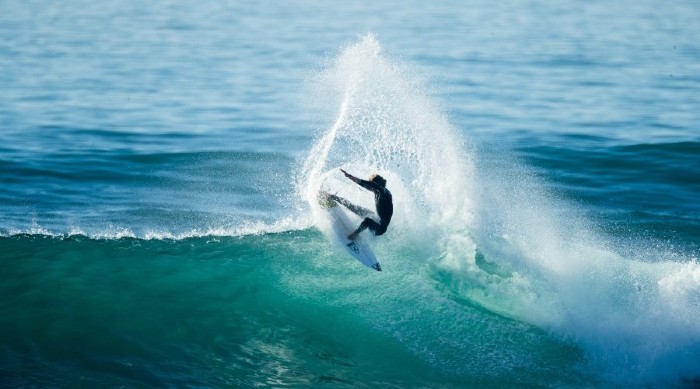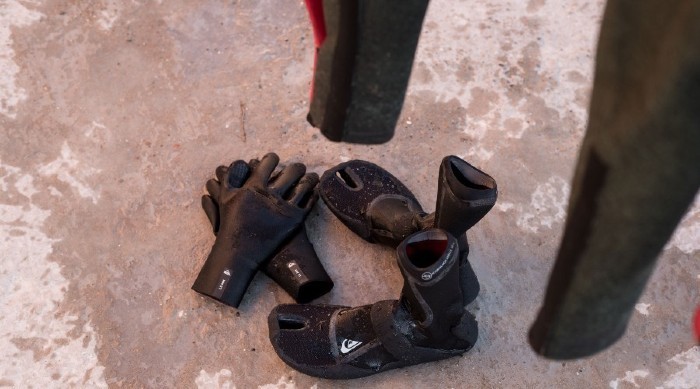A Guide To Understanding Wetsuit Thickness

Gone are the days of surfing in a footy jumper and running to a fire on the beach to get warm. We’ve gone from those humble beginnings decades ago, to where we are with wetsuit technology today that allows us to brave colder waters for longer sessions. The level of warmth todays’ wetsuits opens up new surf locations for exploration making cold water locations more bearable.
The thickest wetsuit isn’t always your best option. Overheating while surfing is just as annoying as getting too cold in the water. To help you get the right balance of thickness/warmth, we’ll cover everything you need to know about wetsuit thickness and temperature in this guide.
A Quick Note on Wetsuit Thickness
Choose a wetsuit thickness based on the water temperature of your local surf spot and climate. Wetsuits with two or more numbers feature different thicknesses. For warmth, the thickest neoprene is centred at the core of the body while arms and legs feature thinner neoprene for flexibility and easier paddling.
The colder the water you surf in, the thicker your suit will need to be to keep you warm. For example, during the colder winter months you might wear a 2mm full suit in Queensland; a 3/2mm full suit in the Greater Sydney region and a 4/3mm full suit in Victoria and Tasmania. The thicker your neoprene is, the better the insulation it provides, but the thicker a suit is the less flexibility and performance it has.
When picking the right wetsuit thickness for your needs, keep in mind your personal preferences and tolerance for cold. If your feet are numb and you’ve got the shivers, the weight savings from opting for a thinner suit won’t matter too much if you’re too cold to paddle or unable to feel your feet when you stand up. Wearing booties, gloves and a hood can offer all-day warmth, even in the iciest of conditions.
Sitting and waiting for your next ride in a wetsuit that is too thin will have a negative impact on your performance and your sessions as a whole. For example surfing in the cold waters of Victoria, your wait time in between sets can be upwards of 20 minutes. Conversely, if you are surfing in a wave pool, you’re guaranteed a ride every few minutes so flexibility in your suit is something you might want to consider.
Wetsuit Thickness and Temperature Guide
Always consider your personal tolerance for cold. People who run warm may opt for thinner suits, while others need more neoprene to keep cozy. The trade-off of thicker neoprene can mean more work when paddling and moving around in the water.
| Water Temperature (°C) | Wetsuit Thickness | Type of Wetsuit + Accessories | Weather Considerations | Seam Seal |
| Above 25°C | None! | Option for rashguard for sun and skin protection | If the wind is strong or you’re out dusk and dawn consider a jacket | Flatlock |
| 20°C-25°C | 0.5mm to 2mm | Jacket, spring suit | Depending on the wind go for a long or short sleeved neoprene jacket paired with boardshorts. If there is a definite chill in the air a traditional shortie is the go. | Flatlock |
| 15°C-20°C | 3/2mm | Full suit | Surfing in windy conditions? Look for a suit with a rubber smoothy panel on the back and chest — this helps block those chilly breezes. | Flatlock or Sealed |
| 13°C-15°C | 4/3mm | Full suit + booties (optional) | When you’ve gone from brisk to cold, it’s time to get out the thicker suit. If you’re going for longer sessions grab a pair of booties — anything in the 3mm to 5mm range will work with these conditions. | Sealed, Sealed + Taped |
| 10°C-13°C | 5/4mm | Full hooded suit + booties + gloves or mittens | Reserved for extreme latitudes and the winter months. | Sealed + Taped |
| 5°C-10°C | 6/5/4mm | Full hooded suit + booties + mittens | Generally the thickest suits. Go extra thick on booties and mittens for these conditions — think 7mm range. | Sealed + Taped |
Your Activity Level and Wetsuit Thickness
Another important factor to consider when shopping for new wetsuits is the intensity of your activity level. How active you are in the water dramatically affects how warm you’ll be out there. You don’t want to pick a wetsuit that’s too thick if you’re surfing at a high intensity. Running a suit too thick may lead to overheating, exhaustion and risk dehydration. On the opposite end of that scale is if you’re more selective about waves you’ll probably want a thicker suit that will keep you toasty longer between longer period sets.
Other Things to Consider When Choosing What Wetsuit Thickness You Need

Water temperature and activity levels aren’t the only factors to consider when choosing the thickness of your wetsuit. Other variables of windy conditions, sun and personal tolerance for cold should all be considered. In windy conditions look for a wetsuit with a rubber panel (also called smoothie) on the chest and or back. This helps minimise the amount of windchill cutting through you. The other bonus of getting a smoothie is that it acts like a solar panel of sorts and attracts the sun when it’s out and about.
If you’re surfing in overcast, rainy or just straight freezing cold conditions (more than you normally surf in) you should consider stepping up to the next wetsuit thickness as the sun won’t warm you. Whichever wetsuit thickness you decide on, it’s important to pick the right size of wetsuit and take care of it along the way. Check out our guide to getting the right fit and how to care for your wetsuit for more insight and tips to stay warm and comfortable in the water, no matter what the conditions throw at you.












